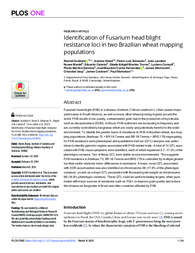Identification of Fusarium head blight resistance loci in two Brazilian wheat mapping populations.
Identification of Fusarium head blight resistance loci in two Brazilian wheat mapping populations.
Autoria: GODDARD, R.; STEED, A.; SCHEEREN, P. L.; MACIEL, J. L. N.; CAIERAO, E.; TORRES, G. A. M.; CONSOLI, L.; SANTANA, F. M.; FERNANDES, J. M. C.; SIMOONDS, J.; UAUY, C.; COCKRAM, J.; NICHOLSON, P.
Resumo: Abstract Fusarium head blight (FHB) is a disease of wheat (Triticum aestivum L.) that causes major yield losses in South America, as well as many other wheat growing regions around the world. FHB results in low quality, contaminated grain due to the production of mycotoxins such as deoxynivalenol (DON). In Brazil, FHB outbreaks are increasing in frequency and are currently controlled by fungicides which are costly and potentially harmful to the wider environment. To identify the genetic basis of resistance to FHB in Brazilian wheat, two mapping populations (Anahuac 75 × BR 18-Terena and BR 18-Terena × BRS 179) segregating for FHB resistance were phenotyped and quantitative trait loci (QTL) analysis was undertaken to identify genomic regions associated with FHB-related traits. A total of 14 QTL associated with FHB visual symptoms were identified, each of which explained 3.7?17.3% of the phenotypic variance. Two of these QTL were stable across environments. This suggests FHB resistance in Anahuac 75, BR 18-Terena and BRS 179 is controlled by multiple genetic loci that confer relatively minor differences in resistance. A major, novel QTL associated with DON accumulation was also identified on chromosome 4B (17.8% of the phenotypic variance), as well as a major QTL associated with thousand-grain weight on chromosome 6B (16.8% phenotypic variance). These QTL could be useful breeding targets, when pyramided with major sources of resistance such as Fhb1, to improve grain quality and reduce the reliance on fungicides in Brazil and other countries affected by FHB.
Ano de publicação: 2021
Tipo de publicação: Artigo de periódico
Unidade: Embrapa Trigo
Palavras-chave: Doença Fúngica, Doença de Planta, Fungo, Fusarium, Trigo
Observações
1 - Por padrão são exibidas publicações dos últimos 20 anos. Para encontrar publicações mais antigas, configure o filtro ano de publicação, colocando o ano a partir do qual você deseja encontrar publicações. O filtro está na coluna da esquerda na busca acima.
2 - Para ler algumas publicações da Embrapa (apenas as que estão em formato ePub), é necessário ter, no celular ou computador, um desses softwares gratuitos. Sistemas Android: Google Play Livros; IOS: iBooks; Windows e Linux: software Calibre.
Acesse outras publicações
Acesse a Base de Dados da Pesquisa Agropecuária (BDPA) para consultar o acervo completo das bibliotecas da Embrapa.

